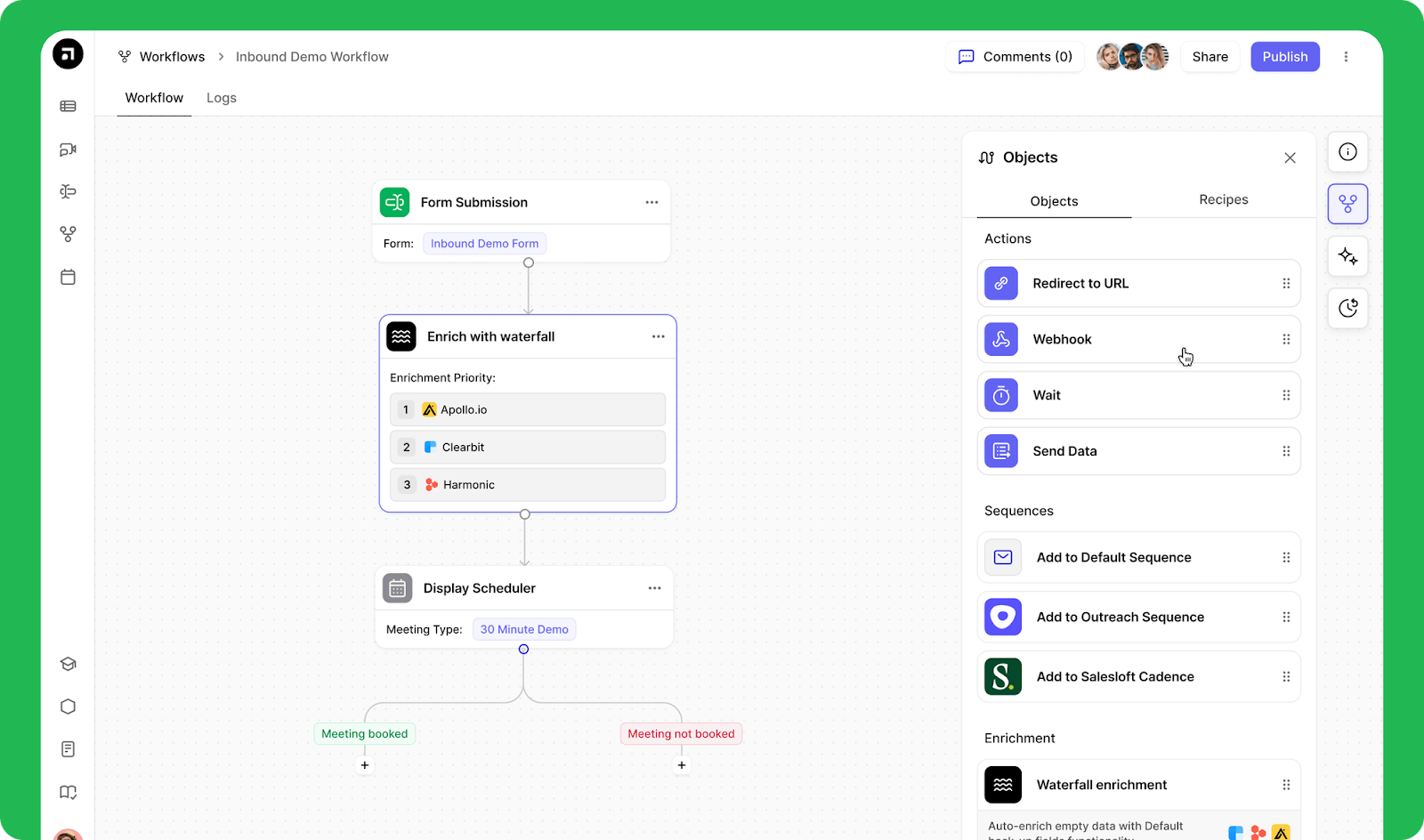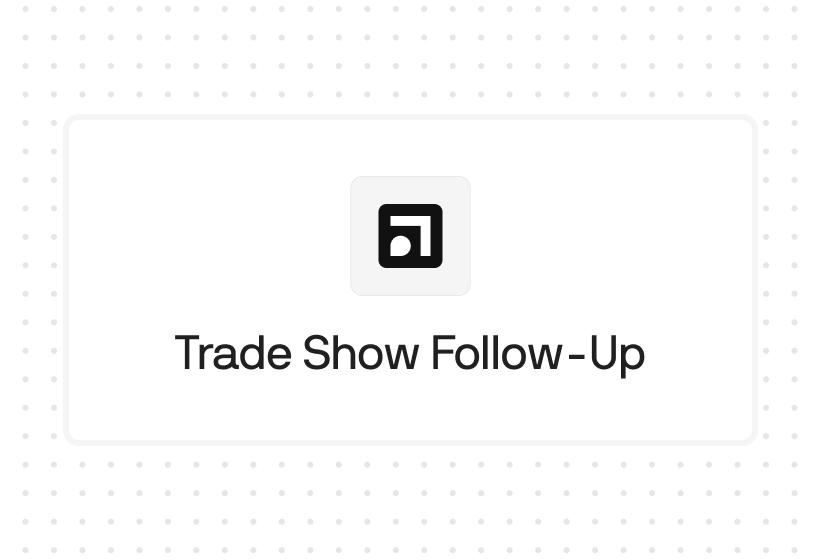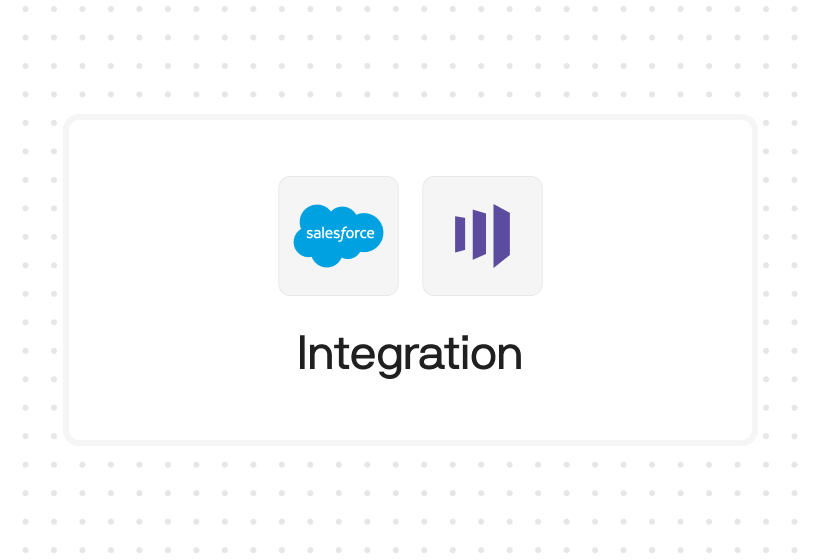Try Default

See how revenue teams automate revenue operations with Default.

Key Takeaways
- Predictive lead scoring uses AI and historical conversion data to rank leads by real sales potential—not arbitrary point systems.
- It surfaces high-intent prospects earlier by analyzing behavioral, firmographic, and engagement signals across your GTM stack.
- Models adapt automatically as inbound volume grows, reducing RevOps workload while keeping scoring accurate and scalable.
- The result: higher conversion rates, lower CAC, and more pipeline from the same headcount—so reps focus on deals that actually close.
Scoring leads based on email opens and job titles might’ve worked when inbound volume was manageable. Today, GTM teams face a different reality: flooded pipelines, inconsistent qualification, and too much time wasted on leads that will never convert.
According to industry research, sales reps spend up to 50% of their productive time on unqualified leads, hurting pipeline confidence and inflating CAC.
This is where predictive lead scoring changes the game.
By analyzing historical conversion data and applying machine learning, it ranks leads by their true likelihood to buy. The guesswork disappears—reps focus on high-fit leads, pipeline efficiency improves, and CAC comes down.
In this guide, you’ll learn:
- What predictive lead scoring is—and how it differs from traditional methods
- How it actually works (data inputs, modeling, and scoring logic)
- A step-by-step framework to implement it effectively
- Key mistakes to avoid, and what “good” looks like
By the end of this guide, you’ll know exactly how to replace guesswork with data-driven scoring and build a funnel that converts with precision.
What is predictive lead scoring?
Predictive lead scoring ranks leads by their likelihood to convert—using historical outcomes, not guesswork.
Instead of assigning static points for actions like “opened an email,” it applies machine learning to patterns across your CRM, marketing automation, website engagement, and win/loss data. Variables like firmographics, behavioral signals, and buying triggers are analyzed together to generate a real-time probability score.
For example, a model might learn that mid-market companies engaging with pricing content and responding within 48 hours convert at 3x the average rate. When a new lead matches that pattern, it rises to the top automatically.
The result is a scalable, consistent way to prioritize sales—flagging high-fit leads early while filtering out the noise.
Predictive lead scoring vs. traditional lead scoring
Lead scoring can be done two ways: manually with static rules, or predictively with machine learning. The difference is speed, accuracy, and scalability—one struggles under modern GTM motion, the other adapts and improves over time.
Predictive lead scoring
Predictive lead scoring uses machine learning to analyze historical win/loss data and behavioral signals across your CRM, marketing automation, and web engagement. Instead of arbitrary points, it identifies patterns that actually drive conversions—like specific content sequences, persona interactions, or response times. The model evolves continuously, aligning Sales, Marketing, and RevOps on which leads are worth chasing.
Traditional lead scoring
Traditional scoring assigns manual points to actions like email opens or job titles. While simple to set up, it relies on assumptions, biases, and static logic that don’t reflect real buying intent. These models require constant tuning, break under high inbound volume, and often lead to wasted rep hours and misaligned expectations across GTM teams.
Example in action: A traditional system might assign 10 points if someone downloads a whitepaper and 15 points if their title includes “VP.” Predictive scoring, however, could reveal that VPs who only consume top-of-funnel content rarely convert—while IT Directors who engage with pricing pages within a week are far more likely to buy. The former looks promising in a manual system; the latter closes deals in a predictive one.
Which lead scoring method should you use?
If you want higher conversion rates, lower CAC, and scalable GTM alignment, predictive lead scoring isn’t optional—it’s essential. Traditional methods may work in small, early-stage environments, but they can’t keep up with modern inbound velocity or complex buyer journeys.
How predictive lead scoring works
Now for a closer look at how predictive lead scoring works in practice:
Collecting the data
The system pulls from across your GTM tool stack—CRM records, MAP platforms, website analytics, sales activity, content engagement, firmographics, and even product usage. Clean, normalized data means the model isn’t guessing; it’s learning from reality.
Example in action: pulling lifecycle data from your CRM and website analytics might reveal that demo requests from specific industries convert 2x faster than average inbound leads.
Finding conversion patterns
Machine learning scans historical wins and losses to uncover what really drives outcomes: multi-touch journeys, content sequences, sales touches, time-to-response, persona-level engagement. These patterns define what “sales-ready” looks like for your ICP—removing the bias of opinion-based scoring.
Example in action: the model might discover that buyers who read two case studies and respond within 24 hours of outreach convert at 40% higher rates.
Building and refining the model
The model weights key attributes and behaviors by their predictive value. As new deals are logged, it self-corrects—getting sharper every cycle. For Marketing, that means confidence that MQLs actually convert; for Sales, it means fewer dead-end handoffs.
Example in action: if pricing page visits prove more predictive than webinar attendance, the model automatically adjusts weighting—no manual intervention required.
Applying the scoring formula
Every new lead is scored dynamically—often on a 0–100 scale—based on fit against proven conversion blueprints. Scores instantly trigger routing, prioritization, or personalized follow-ups.
Example in action: a lead scoring 85/100 is routed to SDRs for immediate outreach, while a 40/100 is placed in a nurture sequence.
The role of AI and machine learning
AI handles what humans can’t: evaluating nonlinear patterns across thousands of signals. It reduces bias, detects intent humans miss, and adapts continuously to market shifts.
Example in action: AI might highlight that “time-to-first-response” is twice as predictive as lead source—an insight no human would’ve spotted at scale.
Together, these steps turn scattered activity into a reliable conversion blueprint. Predictive lead scoring doesn’t just label leads—it continuously learns from outcomes, adapts with your market, and ensures every rep spends time where it matters most.
Benefits of predictive lead scoring for your business
Predictive lead scoring is a high-leverage driver of GTM performance. By aligning teams on what “sales-ready” really looks like, it improves conversion rates, reduces wasted rep time, and strengthens pipeline quality. The impact is clear: more revenue from the same headcount, lower CAC, and faster speed-to-lead.
Here’s how it creates measurable impact:
Prioritize sales efforts with data, not assumptions
Without predictive scoring, reps often chase leads that look active but lack true intent—burning hours on accounts that never close. Predictive models filter signal from noise, ranking leads by conversion probability using behavioral, firmographic, and historical data. That clarity gives Sales a consistent, objective way to focus effort where pipeline is most likely to materialize.
Increase conversion rates across every stage
Because predictive scoring highlights patterns tied to actual buying behavior, it allows teams to engage prospects at the right moment, with the right message. This alignment reduces friction at handoff points—MQL to SQL, SQL to opportunity, opportunity to close—and strengthens funnel progression overall. In practice, companies that shift from manual to predictive scoring often see double-digit percentage lifts in stage-to-stage conversion rates.
Scale qualification without bloating RevOps
Manual scoring rules demand constant upkeep. Every new campaign, every channel shift, every market change creates another tuning exercise for operations. Predictive models adapt automatically as more data flows in. This removes hours of maintenance work, reduces debate over “lead quality,” and allows RevOps to focus on higher-value projects instead of firefighting scoring logic.
Reduce customer acquisition cost (CAC)
By concentrating effort on the leads most likely to convert, predictive scoring directly lowers the cost of acquisition. Fewer wasted sales cycles mean more closed revenue per dollar spent on marketing and headcount. Over time, this efficiency compounds—helping companies grow faster without ballooning their cost base.
Align Sales, Marketing, and RevOps on lead quality
Perhaps the biggest benefit is cultural. When lead quality is judged on opinion, trust erodes between teams. Predictive scoring replaces guesswork with evidence: Marketing validates its MQLs against actual outcomes, Sales receives cleaner handoffs, and RevOps has a single source of truth to optimize against. This alignment accelerates response times, improves pipeline confidence, and cuts down on the finger-pointing that stalls revenue growth.
These benefits compound over time. The more data your model consumes, the smarter it gets—unlocking a self-reinforcing cycle of cleaner pipeline, sharper focus, and faster revenue growth.
How to implement predictive lead scoring in 7 steps
Predictive lead scoring succeeds when data, tools, and teams are aligned. Implementation isn’t a one-off setup—it’s an ongoing framework that turns raw information into actionable prioritization. Done right, it strengthens every stage of the funnel.
Here’s how to roll it out with precision and impact:
1. Audit your data readiness
Pressure-test your CRM and MAP data before building. Are lead sources clean? Are lifecycle stages tracked consistently? Do you log closed-lost reasons?
If data is incomplete, your lead scoring model learns from noise. If it’s clean, you unlock accurate, trusted scoring from day one.
2. Define your ICP and conversion milestones
Align Sales, Marketing, and RevOps on a shared ICP and clear conversion definitions (SQL creation, opp stage, closed-won, etc.).
Skipping this step means Sales won’t trust the scores. Getting it right ensures everyone optimizes against the same outcome.
3. Choose the right platform
Go beyond static point scoring or checkbox lead enrichment. You need a system that ingests historical data, supports ML-based modeling, and activates workflows in real time.
Default combines enrichment, scoring, and routing into a single no-code workflow—so you operationalize insights immediately instead of patching tools together.

4. Feed the model historical sales data
Import structured lead and opportunity data: wins, losses, engagement timelines, persona roles, campaign touches, and funnel progression.
Better training data = higher accuracy. Weak input = a model your reps won’t trust.
5. Train, test, and calibrate
Run the model on past leads and compare predicted scores against actual outcomes. Identify false positives (looked good but didn’t close) and false negatives (looked weak but won).
This builds confidence and ensures your model is predictive—not just another black box.
6. Operationalize scoring across GTM workflows
Push scores into your CRM. Route hot leads instantly. Tier SDR/AE workflows around score bands. Trigger personalized sequences automatically.
Scoring is only valuable if it drives action; otherwise, it’s just another dashboard that no one uses.
7. Track impact and iterate continuously
Monitor KPIs like lead-to-opportunity rate, opp-to-close rate, rep time-to-first-touch, and pipeline coverage by score tier. Update the model as segments, channels, or messaging evolve. The best models aren’t static—they adapt alongside your GTM motion.
Pro tip: Start small. Roll out predictive scoring in one region, channel, or segment before scaling company-wide. It builds early wins, gives you time to refine, and creates internal advocates for adoption.
The biggest mistakes teams make with predictive scoring
Even the best predictive scoring models fail if the foundation is weak or the execution is siloed. Avoid these common missteps that quietly erode performance, sales confidence, and cross-functional trust.
Using incomplete or inconsistent data
Predictive scoring depends on clean, reliable historical data. If your CRM is full of blanks, duplicates, or poorly tracked lifecycle stages, the model will surface misleading patterns. For example, a lead marked “closed-lost” without a reason can distort the model’s assumptions about what disqualifies an account.
The fix is straightforward but critical: audit your CRM, normalize key fields, and establish data hygiene routines before feeding anything into the model.
Hardcoding static rules alongside predictive
Many teams are tempted to add manual rules on top of predictive outputs—for instance, “always add points for pricing page visits.” The problem is that these static rules reintroduce bias and can directly contradict what the model has learned. Sales ends up seeing scores that feel arbitrary, which undermines adoption.
If guardrails are needed, apply them in routing workflows, not in the scoring logic itself.
Skipping model validation
Launching a model without testing it against past data is one of the fastest ways to lose Sales confidence. If high scores don’t actually convert, reps will dismiss the system as another “black box.”
Before rollout, compare predictions against historical outcomes—did top-quartile scores actually win at higher rates? Did low-quartile scores close occasionally? This validation builds trust and gives you the chance to fine-tune before going live.
Poor GTM alignment on scoring thresholds
Even the best scoring model fails if GTM teams can’t agree on what the outputs mean. Marketing might see a “70/100” as sales-ready, while Sales insists it’s still nurture-stage. Without alignment, you get early handoffs, missed opportunities, and wasted cycles.
The solution is to define thresholds collaboratively, document them, and build SLAs around how each tier is handled. Predictive scoring only drives impact when it’s consistently acted on.
Pro tip: Treat predictive scoring like a living system. Schedule quarterly reviews with Sales, Marketing, and RevOps to validate accuracy, recalibrate thresholds, and reinforce trust across teams.
Predictive lead scoring in action
Imagine you’re a B2B SaaS company targeting mid-market IT buyers. Over the past year, your CRM reveals that your highest-converting deals share common traits:
- Job titles like “IT Director” or “Head of Infrastructure”
- 200–1,000 employees
- Multiple pricing page visits within a 7-day window
- Engagement with a technical case study or comparison guide
- Direct outreach via chatbot or demo request
A predictive model is trained on this historical data. It detects these patterns—frequency, recency, asset type, persona fit—and weights them accordingly.
Impact: When a new lead matches these traits, the system instantly assigns a high score, routes it to the right SDR, and queues it for rapid follow-up. Reps no longer dig through the CRM guessing who’s worth the time—they engage the right accounts, at the right moment, with the right message.
The result? Higher conversion rates, faster speed-to-lead, and less wasted pipeline effort.
Operationalize predictive lead scoring with Default
Most teams know they need better lead scoring—but get stuck trying to stitch together enrichment, scoring, routing, and follow-up across multiple tools.
The result? Slow lead response times, misrouted accounts, and revenue left on the table.
Default simplifies the entire process. With one platform, you can:
- Enrich inbound leads automatically
- Score them against proven conversion patterns
- Route them instantly to the right rep or sequence
- Trigger follow-ups in real time based on lead quality and timing
All in one no-code workflow. No dev work. No manual patching. Just faster speed-to-lead, higher pipeline coverage, and more closed revenue.
Ready to stop guessing and start converting? Try Default to operationalize predictive lead scoring—end to end.
FAQ
What is predictive lead scoring vs. opportunity scoring?
Predictive lead scoring ranks new or early-stage leads based on their likelihood to convert, using behavioral, firmographic, and historical data. Opportunity scoring focuses on open deals—using stage progression, engagement, and past win rates to predict close probability. Both use AI, but at different funnel stages. Together, they tighten forecasting and focus rep time where it matters most.
What is predictive lead scoring in Dynamics 365 Sales?
Dynamics 365 includes built-in AI models that score leads based on CRM signals like source, role, and activity. While useful, these models are limited in customization and accuracy compared to dedicated platforms. Default takes a broader data set, adds AI lead enrichment, and operationalizes workflows in real time.
How can I measure the success of predictive lead scoring?
Track metrics that reflect both efficiency and conversion performance:
- Lead-to-opportunity conversion rate
- Opportunity-to-close rate by score tier
- Rep time-to-first-touch
- Pipeline velocity and coverage by score band
Improvement in these areas signals your model is driving ROI through faster handoffs, higher win rates, and reduced CAC.
Can predictive lead scoring replace traditional lead scoring entirely?
In most cases, yes. Predictive models outperform static rules in accuracy, scalability, and adaptability—especially when data is clean and inbound volume is high. Some teams layer in simple firmographic filters (like industry or revenue) for added control, but predictive should always be the foundation.
Conclusion

Former pro Olympic athlete turned growth marketer! Previously worked at Chili Piper and co-founded my own company before joining Default two years ago.
Accelerate your growth with Default.
Revamp inbound with easier routing, actionable intent, and faster scheduling















.png)








%201.svg)



.svg)





%201.svg)



%201.svg)

